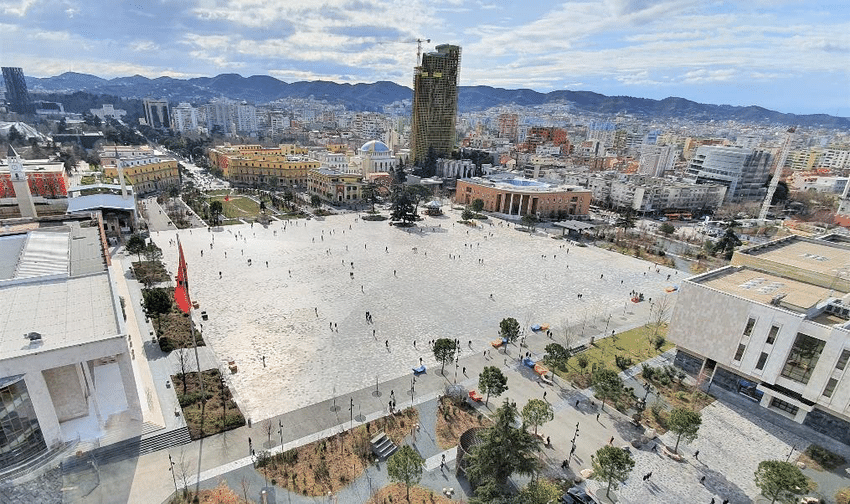Skanderbeg Square, known as Sheshi Skënderbej in Albanian, is the central and most iconic public space in Tirana, Albania’s capital
Named after the national hero Gjergj Kastrioti Skanderbeg, who led a resistance against the Ottoman Empire in the 15th century, the square is a focal point for both locals and visitors. Here’s a deeper dive into the significance and features of Skanderbeg Square:
Skanderbeg Square is not just the heart of Tirana; it is the living symbol of Albania’s unity, resilience, and the enduring spirit of its people.
Anna Apartments
Historical and Cultural Significance
Historical Role: Skanderbeg Square has been the center of Tirana since the city’s early days as the capital, evolving through different historical periods, including the Ottoman era, Italian occupation, communism, and modern Albania. Over time, it has played host to numerous political rallies, national celebrations, and public gatherings, symbolizing the heart of Albanian civic life.
Renovation and Design: The square underwent a major renovation in 2017, transforming it into a vast pedestrian area covering more than 40,000 square meters. The redesign was led by Belgian architecture firm 51N4E, who reimagined the space as a unifying civic plaza, open and accessible to everyone. The new design reflects Albania’s geographic diversity, with stones from different regions of the country embedded in the square’s surface, symbolizing unity.
Cultural Hub: Skanderbeg Square is surrounded by some of Tirana’s most important cultural institutions. These include the National History Museum, the National Opera and Ballet Theatre, and the National Library. The square acts as a cultural hub, providing easy access to these landmarks and making it a starting point for exploring the city’s rich history and culture.
Key Features of Skanderbeg Square
- Statue of Skanderbeg: At the center of the square stands the equestrian statue of Skanderbeg, a national hero who is celebrated for his role in resisting the Ottoman Empire. The statue, created by sculptors Odhise Paskali, Andrea Mana, and Janaq Paço, was erected in 1968 to mark the 500th anniversary of Skanderbeg’s death. The imposing bronze figure is a powerful symbol of Albanian pride and independence.
- The Fountain: The square features a large, circular fountain that has become a popular spot for relaxation and play, especially for children. The fountain is particularly beautiful at night when it is illuminated, adding to the square’s vibrant atmosphere.
- The Pedestrian Area: The renovation of the square emphasized pedestrianization, turning it into one of the largest car-free zones in the Balkans. The wide open space, free of traffic, is perfect for leisurely strolls, public events, and social gatherings. The square’s surface is made up of large, flat stones from different regions of Albania, a design choice that creates a unique mosaic reflecting the country’s natural landscape.
- Landscape and Greenery: Although predominantly a paved space, the square includes sections of greenery with trees and plants. These areas offer shaded spots for sitting and relaxing, breaking up the expanse of stone with natural elements.
- Cultural Events: Skanderbeg Square is a major venue for public events in Tirana, including concerts, festivals, political rallies, and national celebrations. On important national holidays, such as Independence Day (November 28) and Liberation Day (November 29), the square becomes the center of grand celebrations with parades, performances, and fireworks.
- Panoramic Views: The square is surrounded by several key buildings that provide a stunning backdrop, including the Et’hem Bey Mosque with its minaret, the Clock Tower, and the modern structures that have sprung up in recent years. The architectural contrast between the historical and contemporary buildings around the square adds to its dynamic and evolving character.
Surrounding Landmarks
- National History Museum: Located on the northwest side of the square, the National History Museum is the largest museum in Albania and offers a detailed exploration of the country’s history from ancient times to the modern era. The building’s large mosaic on the facade, titled “The Albanians,” depicts key figures and moments in Albanian history.
- Et’hem Bey Mosque: On the southeast side of the square, the Et’hem Bey Mosque is a significant cultural and religious site. It is one of the few historical buildings in Tirana that survived the communist regime’s atheism campaign. The mosque, with its beautifully decorated interior, is open to visitors and remains an active place of worship.
- Clock Tower (Kulla e Sahatit): Adjacent to the Et’hem Bey Mosque, the Clock Tower is one of Tirana’s most recognizable landmarks. Built in 1822, it offers visitors the opportunity to climb to the top for panoramic views of the square and the city.
- National Opera and Ballet Theatre: Situated on the south side of the square, this building is home to Albania’s principal performing arts institutions, including the national opera, ballet, and symphony. The theater hosts regular performances and is a key part of Tirana’s cultural scene.
Skanderbeg Square is more than just a public space; it is the symbolic and physical heart of Tirana, representing the city’s historical journey and its vibrant present. Whether you’re interested in history, culture, or simply soaking in the atmosphere, Skanderbeg Square is a must-visit destination in Tirana.
